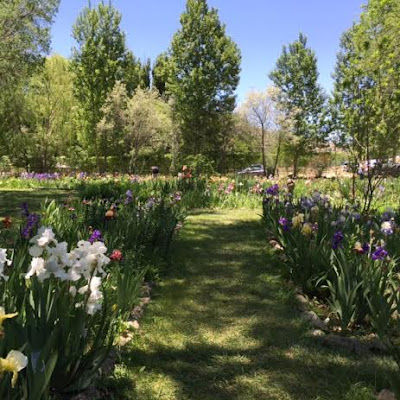I've always wanted to take a trip to the Hondo Iris Farm, located a couple of hours away from Las Cruces in the Hondo Valley of New Mexico. Today we combined a visit there to see the irises in bloom with a picnic on the grounds. Lovely!
We drove to the other side of the Organ Mountains, through the Tularosa Basin, up into the Sacramento Mountains, and through the mountain town of Ruidoso. Along the way we passed a missile base test facility, the White Sands National Monument, the Mescalero Apache Reservation, the Inn of the Mountain Gods Resort and Casino, the Hubbard Museum of the American West, and the Ruidoso Downs Race Track.
Scenery-wise, we traveled from the pecan orchards and chile fields of our own irrigated Mesilla Valley, through bare rocky mountains, along a desert road through ancient lake beds, up through some pine tree mountains, and down through some very barren and dry hills to the place where the Hondo Valley starts.
Oh, that Hondo Valley! It hit these desert eyes with a big blast of green, just like the oasis it is in a dry land. The waters of the Rio Hondo, Rio Bonito, and Rio Ruidoso meet here and irrigate the grazing fields, orchards, and vegetable farms in that good bottom land.
After passing by the little villages of Glencoe and San Patricio, we came to Hondo and took the turnoff into the grounds of the Hondo Iris Farm. The pictures below should tell the rest of the story.
There were lots of shade trees, always appreciated by New Mexicans.
I love the contrasting foliage of these trees.
Here is the garden--lots of irises, interspersed with lilies,
some hollyhock seedlings, and peonies. The fragrance was wonderful.
Not such a good shot of the flowers, but we always love the shade!
There were roses, too.
St. Francis, being dwarfed by a huge iris bloom.
I brought home several potted irises and a peony for our own garden. I loved our peonies back in New Hampshire and somehow never realized that they can be grown here. We also brought home a catalog and I'll be choosing more iris varieties to pick up from the farm in July.
I guess I have some digging to do to make some beds out back for the new plants. I think our chicken girls will enjoy the view of all those blossoms next year.
A couple of the irises I brought home: Fiery Temper
Nigerian Raspberry















